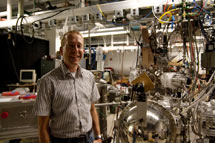
Handy Links
SLAC News Center
SLAC Today
- Subscribe
- Archives: Feb 2006-May 20, 2011
- Archives: May 23, 2011 and later
- Submit Feedback or Story Ideas
- About SLAC Today
SLAC News
Lab News
- Interactions
- Lightsources.org
- ILC NewsLine
- Int'l Science Grid This Week
- Fermilab Today
- Berkeley Lab News
- @brookhaven TODAY
- DOE Pulse
- CERN Courier
- DESY inForm
- US / LHC
SLAC Links
- Emergency
- Safety
- Policy Repository
- Site Entry Form

- Site Maps
- M & O Review
- Computing Status & Calendar
- SLAC Colloquium
- SLACspeak
- SLACspace
- SLAC Logo
- Café Menu
- Flea Market
- Web E-mail
- Marguerite Shuttle
- Discount Commuter Passes
-
Award Reporting Form
- SPIRES
- SciDoc
- Activity Groups
- Library
Stanford
Around the Bay
Humboldt Awardees Explore Superconductivity at SLAC and Abroad
The Alexander von Humboldt Foundation has recognized two more members of the Stanford Institute for Materials and Energy Science with research awards, in addition to the recent fellowship award to Anders Nilsson. The foundation's prestigious awards offer researchers with notable achievements opportunities to do potentially groundbreaking research in German universities and abroad. For SIMES researchers Tom Devereaux and Patrick Kirchmann, that involves exploring the mechanism of superconductivity in a recently-discovered class of superconductors, iron pnictides.
Devereaux, a former Humboldt Fellow, received a Humboldt Foundation Prize, given to alumni fellows to support a long-term research project. Devereaux shares the prize with long-time collaborator Rudi Hackl from the Walther-Meissner-Institut in Germany. The prize provides support for research projects of the recipient's choosing. Devereaux will work on developing theories of an X-ray based materials research method called advanced light scattering spectroscopy and its applications for the study of superconductivity. Along with Hackl, he will spend part of his fellowship at the Bavarian Academy of Sciences in Munich, Germany.
Newly arrived SIMES post doctoral researcher Patrick Kirchmann received the Humboldt Foundation's Feodor Lynen Fellowship. The Lynen award provides German postdocs with up to two years of support for research work abroad, under the guidance of a previous Humboldt fellow. The prize has allowed Kirchmann to travel here from the Fritz Haber Institute of the Max Planck Society in Berlin to work at SIMES.
"It's a scientific ambassador program," Kirchmann said. Devereaux will mentor Kirchmann as his Humboldt host at SIMES, while SIMES Director Zhi-Xun Shen supervises his everyday research. The three will study the superconductive properties of iron pnictides in an effort to understand previously-unknown physical properties that might explain their unusual ability to superconduct at higher temperatures. One such property is the electronic band dispersion, which gives an electron's energy range for a certain material.
Superconductors are materials that can conduct electricity without building up heat and losing energy. Normally, negatively-charged electrons will repel each other, bouncing and scattering inefficiently as they flow through a conductor, resulting in wasted energy given off as heat. But in a superconducting state, they will form pairs and thus become harder to dissipate, so they flow smoothly through the material without losing energy. Conventional superconductors must be extremely cold before the will superconduct—on the order of negative 400 degrees Fahrenheit. So called "high-temperature" superconductors, in contrast, can operate at temperatures as warm as minus 210 degrees Fahrenheit.
"Conventional theory cannot describe why high-temperature superconductivity occurs," Kirchmann said. "There are still lots of open questions. It takes a lot of time to establish a foundation of knowledge."
Scientists have known about the superconductive properties of cuprates, a class of ceramic materials, for quite some time. But two years ago, a Japanese scientist discovered that a second group of materials, known as iron pnictides, are also capable of superconductivity, and at less-frigid temperatures. Devereaux, Shen and Kirchmann will be focusing their research at SIMES on this second, newer class of superconductors. They will try to detail certain material properties of these iron pnictides. For example, the fundamental concept of the Fermi surface describes many useful properties of a material, such as how well it will conduct heat and how efficiently it will carry an electrical current. The researchers will use the deep ultraviolet wavelength range at SSRL to characterize the Fermi surface of an iron pnictide, such as iron arsenic.
The new project with Devereaux and Shen will be a shift for Kirchmann, who has worked with ultrafast lasers to study certain surfaces, such as metallic nanostructures, up close. But the common ground is surface science, and trying to understand how different materials can advance energy technology.
"It was not a very far-fetched idea to expand my research in this direction," he said. "We're taking the best of two worlds and joining them."
At the end of this fellowship, which has funding for the duration of 2010, Kirchmann intends to return to the Max Planck Institute. He hopes to start his own research group, building on the surface science work he is establishing at SIMES.
—Julie Karceski
SLAC Today, March 23, 2010
